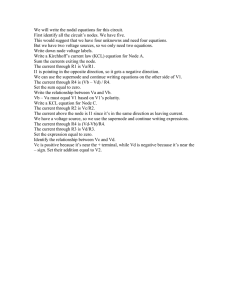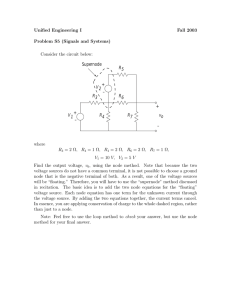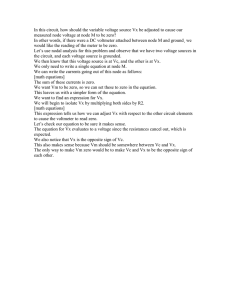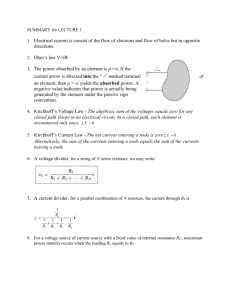Lecture 6
advertisement
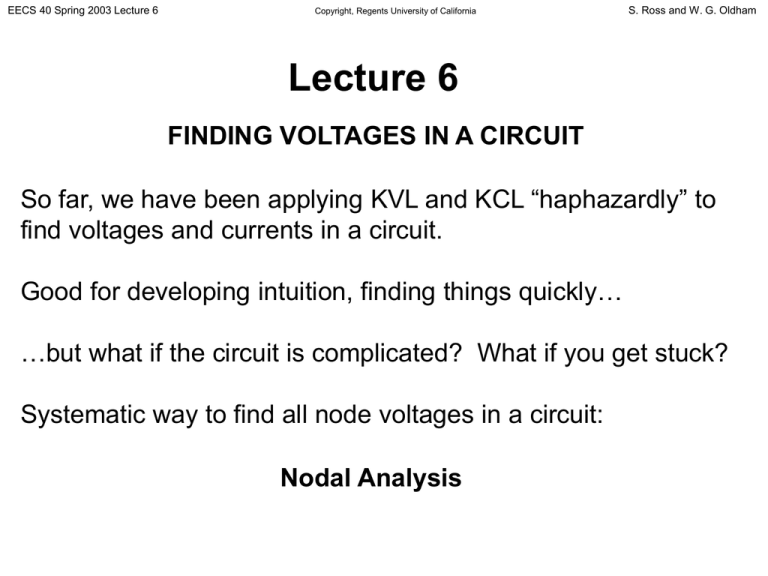
EECS 40 Spring 2003 Lecture 6 Copyright, Regents University of California S. Ross and W. G. Oldham Lecture 6 FINDING VOLTAGES IN A CIRCUIT So far, we have been applying KVL and KCL “haphazardly” to find voltages and currents in a circuit. Good for developing intuition, finding things quickly… …but what if the circuit is complicated? What if you get stuck? Systematic way to find all node voltages in a circuit: Nodal Analysis EECS 40 Spring 2003 Lecture 6 S. Ross and W. G. Oldham Copyright, Regents University of California NOTATION: NODE VOLTAGES The voltage drop from node X to a reference node (ground) is called the node voltage Vx. Example: a + Va _ b + + _ Vb _ ground EECS 40 Spring 2003 Lecture 6 Copyright, Regents University of California S. Ross and W. G. Oldham FORMAL CIRCUIT ANALYSIS USING KCL: NODAL ANALYSIS (Memorize these steps and apply them rigorously!) 1 Choose a reference node (ground, node 0) (look for the one with the most connections!) 2 Define unknown node voltages (those not fixed by voltage sources) 3 Write KCL at each unknown node, expressing current in terms of the node voltages (using the I-V relationships of branch elements*) 4 Solve the set of equations (N equations for N unknown node voltages) * with floating voltages we will use a modified Step 3 EECS 40 Spring 2003 Lecture 6 S. Ross and W. G. Oldham Copyright, Regents University of California EXAMPLE OF NODE ANALYSIS node voltage set R1 + - V1 Va R 3 R2 Vb What if we used different ref node? R4 IS reference node 1. Choose a reference node. 2. Define the node voltages (except reference node and the one set by the voltage source). 3. Apply KCL at the nodes with unknown voltage. Va V1 Va Va Vb 0 R1 R2 R3 Vb Va Vb IS R3 R4 4. Solve for Va and Vb in terms of circuit parameters. EECS 40 Spring 2003 Lecture 6 S. Ross and W. G. Oldham Copyright, Regents University of California EXAMPLE OF NODE ANALYSIS R1 Va R3 V 1 R2 I1 R4 R5 V2 Va V1 Va Va V2 I1 R1 R4 R5 EECS 40 Spring 2003 Lecture 6 S. Ross and W. G. Oldham Copyright, Regents University of California NODAL ANALYSIS WITH “FLOATING” VOLTAGE SOURCES A “floating” voltage source is a voltage source for which neither side is connected to the reference node. VLL in the circuit below is an example. VLL Va Vb - + I1 R2 R4 I2 Problem: We cannot write KCL at node a or b because there is no way to express the current through the voltage source in terms of Va Vb. Solution: Define a “supernode” – that chunk of the circuit containing nodes a and b. Express KCL at this supernode. EECS 40 Spring 2003 Lecture 6 S. Ross and W. G. Oldham Copyright, Regents University of California FLOATING VOLTAGE SOURCES (cont.) Use a Gaussian surface to enclose the floating voltage source; supernode write KCL for that surface. VLL Va - I1 Vb + R2 I2 R4 Two unknowns: Va and Vb. Get one equation from KCL at supernode: Va Vb I1 I2 R2 R 4 Get a second equation from the property of the voltage source: VLL Vb Va EECS 40 Spring 2003 Lecture 6 S. Ross and W. G. Oldham Copyright, Regents University of California ANOTHER EXAMPLE V2 R1 Va Vb | + V1 + R2 R3 R4 Can we choose ground to avoid a floating voltage source? Not in this circuit. Va V1 Va Vb 0 R1 R2 R 4 Vb Va V2
